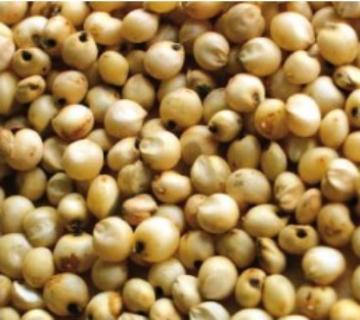
Sorghum (Sorghum bicolor)
Local names: Hindi: Jowar Marathi: Jowari Tamil: Cholam
Sorghum resembles in feeding value to that of maize. It is more drought resistant than maize. The kernel of sorghum is very similar to that of maize, although smaller in size. Like maize, sorghum is also a C4 plant accounting for its high productivity and tolerance to high temperatures.
Nutritive value
Sorghum grain is very similar to maize in composition. It generally contains more protein but less oil than maize and has no pigmenting xanthophylls. Sorghum contains about 65% starch, 80-85% TDN, 2-3% oil and about 8-12% protein. Grains are slightly less palatable than maize because of the presence of tannins. The grains should be ground before feeding the ruminants, otherwise they will escape digestion. Care is needed in the grinding process as this may produce a fine powder, which is pasty and unpalatable. Tannins in sorghum greatly reduce protein availability both in rumen and small intestine. Lysine, threonine and methionine are the limiting amino acids in sorghum. Grains typically have very low calcium, high phytate phosphorus, no vitamin B12 and very little vitamin A activity.
Deleterious factor
The principal deleterious factors in sorghum grain are polyphenolic compounds, known as condensed tannins. Most of the biological effects of tannin are associated with their ability to react with protein. In the digestive tract tannins may react with digestive enzymes reducing nutrient digestibility. They also react with dietary proteins forming indigestible complexes. Various processing methods can be used to overcome the effects of sorghum tannin. Treatment with alkali, such as sodium or ammonium hydroxide or anhydrous ammonia is effective. Polyethelyne glycol which forms complexes with tannins has also been shown to be an effective additive to improve the feeding value of high tannin sorghum.
